Search myodfw.com
Horned puffins have an unmistakable black and white plumage and a large, distinct, yellow and orange bill during the breeding season. They are rare in Oregon, and most commonly encountered dead on the beach in winter or spring, or sighted more than 50 miles offshore in spring. Individual birds, or possibly pairs, occasionally stay in Oregon for the breeding season and are seen attending colonies with Tufted puffins, but there are no records of breeding in Oregon. Hear the call of the Horned puffin

About the size of the domestic pigeon, this swift-flying species is popular among sport hunters. An arboreal bird, it is often observed perched alone on top of a tall tree or in flocks when flying about feeding areas and mineral sites. This is a common summer resident in forested areas west of the Cascade crest. It typically nests in forested mountain areas in the west Cascades. Hear the call of the Band-tailed pigeon Photo by Dave Budeau, ODFW
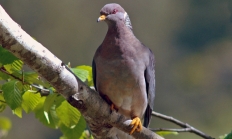
With long, pointed wings, nighthawks can sometimes be seen during the day catching insects while in flight although most are active at night. Nighthawks roost by scraping the ground or roost on low branches. Nestlings can fly at 10 days old. Swifts nest on vertical walls, such as chimneys or old smoke stacks, hollow trees or rock crevices. It's fun to watch them at dusk in summer, circling their nesting site. These birds are never seen perched, but only in flight.

The Costa's hummingbird is a very rare spring and summer visitant to central and southwestern Oregon. Males are sometimes present for the entire year in the Rogue Valley. Males have been observed in canopy-free riparian habitat along Bear Creek and semi-open tall white oaks at the edge of Agate Lake. Many of these birds go undetected in Oregon because of their similarity with other hummingbird species. Hear the call of the Costa's hummingbird Photo by Mick Thompson, Flickr

The bright rusty plumage of the male cinnamon teal, a bird of western North America, is a visual delight. In flight, both males and females show powder blue in the wings as they fly fast and low, timed at nearly 60 miles per hour. They weigh only about one pound. They are a common breeder throughout the state except in western Oregon and the high Cascades. They are most common east of the Cascades. Hear the call of the cinnamon teal Photo by Maxine Wyatt
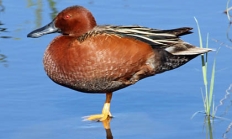
Features: Herring are silver with large scales. They are an important food source for larger fishes, sea birds and marine mammals. Habitat: Herring are frequently offshore in large schools but can be caught inshore in harbors and large estuaries during spawning. Technique: Herring are a schooling fish, and anglers can target them from docks, piers or boats in the bays. The most popular rig is a multiple-hook herring jig. Header photo by Steve, Flickr

This species is found in pine forests, oak woodlands, and in chaparral of southwestern Oregon valleys. It is usually found in, under, or near rotting logs in open wooded areas near streams. The California mountain kingsnake preys upon snakes, lizards, birds and their eggs, and some small mammals. It is an Oregon Conservation Strategy Species in these ecoregions: Coast Range, Columbia Plateau, East Cascades, Klamath Mountains, and West Cascades. Photo by William Grenfell, Flickr

This dark colored salamander has a reddish-brown ragged edged stripe that runs along the top of the head to the tip of the tail with black or dark brown sides. It has a long body and tail and the belly is black with large white flecks. The Oregon slender salamander is a lungless salamander species, relying on its skin to breathe. Mature adults can grow to just under four inches in total length, with females about 12 percent larger than males. Oregon slender salamanders are most common in stable, moist old-growth (late successional and second-growth) forests where there are abundant

The golden-mantled ground squirrel doubtlessly is the most distinctively marked ground squirrel in Oregon; a white stripe bordered on both sides by a black stripe extends from the shoulder to the hip. From nose to nape above the eye, the head is russet. The back between the stripes is grizzled dark grayish-brown becoming less grizzled on the rump; lateral to the stripes the color grades to a light buffy-gold on the venter. The face, shoulders, front legs, and feet are a bright orangish-gold. This ground squirrel occupies the east slope of the Cascade Range and most of central Oregon, and
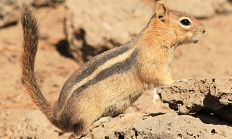
The California sea lion is the mid-sized Oregon otriid. The body is slender and tapering, the flippers are relatively small, and the rear flippers can be rotated beneath the body for moving on land. The short, course pelage lacks dense underfur; when dry, it usually is chocolate brown, but individuals with light-tan pelage are known to occur. The pelage appears black when wet. In older males, the pate is tan. The occurrence of the California sea lion along the Oregon coast is seasonal. The primary areas where it comes ashore are Cascade Head, Tillamook County; Cape Argo, Coos County; and
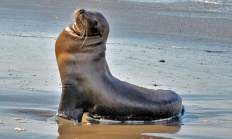
This salt-loving bird is possibly the most abundant grebe in the world. These grebes nest in the large, tule-fringed marshes of southeastern Oregon. They also use almost any open water for feeding after the breeding season. The eared grebe has been reported breeding in nearly every eastern Oregon county, but principal breeding areas are in Klamath, Lake, and Harney counties. It is local elsewhere east of the Cascades. Hear the call of the eared grebe Photo by Dave Budeau, ODFW

These elegant shorebirds are found as often in dry or damp upland areas as they are on mudflats or beaches. The plain brown immature birds of autumn become spangled with black and gold as breeding approaches. It is an occasional to uncommon migrant in western Oregon (mainly coastal) and locally rare, irregular migrant in eastern Oregon, with most reports at Malheur National Wildlife Refuge, in the Klamath Basin (summer) and in Umatilla County. Hear the call of the American golden-plover Photo by Mark Peck, Flickr
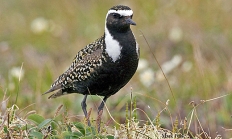
This small, remarkably delicate long-legged wader can be found in migration across most of Oregon. It is speckled gray and white with some variation by season and is typically noticed mincing about in shallow pools and in the water adjacent to mudflats or on seasonally flooded fields, as well as in small isolated ponds. It is an uncommon to common migrant, most birds in fall. In the eastern one-third of Oregon, it usually outnumbers Greater yellowlegs in fall. Hear the call of the Lesser yellowlegs Photo by Dave Budeau, ODFW

Parasitic jaegers are strong, fast fliers with a flash of white on the bases of the underwing primaries. This is the most frequently seen jaeger from shore and it sometimes enters estuaries. They are an uncommon fall and rare spring transient offshore. Their flight is low and unlabored with falcon-like wing-beats that alternate with shearwater-like glides. These birds chase terns and small gulls for up to several minutes until they disgorge food. Hear the call of the Parasitic jaeger Photo by Aaron Maizlish, Flickr

The Southern alligator lizard is found in a variety of habitats from grassland and chaparral to oak woodlands and edges of open coniferous forests, as well as riparian zones and moist canyon bottoms. It requires thickets, brush heaps, downed logs, or rock piles for cover. This carnivorous lizard feeds primarily on small invertebrates (slugs, spiders, centipedes, scorpions, beetles, grasshoppers, and crickets), but also is known to feed on bird eggs, nestlings, other lizards, and small mammals. Photo by Alan Harper, Creative Commons

Greater sage-grouse are best known for their elaborate courtship displays that occur on traditional strutting grounds, known as leks, where males gather each spring. At all seasons, both sexes are readily identified by large size and chicken-like build. Adults are mottled dark gray, black and buff, with black bellies and pointed tails. Males have specializations used in display. Their tail feathers are long and pointed with white spots. They have yellow combs over each eye and a chest sac with two bare, yellow patches of skin which are inflated during display. The display lasts only a few seconds and is

Features: Bullheads present in Oregon are distinguished from channel catfish by their square or rounded tails and lack of spotting. They seldom exceed 18 inches in length and a weight of 2 pounds. Yellow bullheads are a more uniform yellow color with white or cream chin barbels and a rounded tail. Habitat: Bullheads are found on the bottom in the shallows of mud-bottomed ponds, lakes, reservoirs and backwaters of rivers. The yellow bullhead is found mainly in the Willamette basin. Technique: Bullheads can be caught any month of the year, but fishing is best from the first warm days of

Noted for its familiar call, chick-a-dee-dee-dee, the Black-capped chickadee is widely heralded as one of Oregon's friendliest and cheeriest residents. Even in the midst of winter, this bird "fairly overflows with good spirits." The Black-capped chickadee is resident at low to moderate elevations in western Oregon from the Willamette Valley and coastal counties to Douglas County and in most of eastern Oregon with the exception of the southeastern corner of the state. Hear the song of the Black-capped chickadee Photo by Dave Budeau, ODFW

Southern Oregon is the northwest limit of the breeding range of Blue-gray gnatcatcher, which, as its name implies, is an active, diminutive bluish-gray. This is an energetic bird, commonly jerking its tail sharply to one side, wings held below, occasionally spreading its tail. It breeds in numerous disjunct localities and may be expanding its range in Oregon. It is an uncommon to common summer resident in the interior Rogue Valley. Hear the song of the Blue-gray gnatcatcher Photo by John Sutton, Flickr

This colorful bird of coniferous forests and mixed woods is a common breeding species of eastern North America. It winters in the West Indies and Middle America and occasionally in California and the southern United States. It is a regular migrant in very small numbers in spring and irregular in summer and fall in the southwestern United States to California and Oregon and is occasionally found elsewhere in the West. The majority of Oregon records are from late April to late June, mostly from the east of the Cascades. Hear the song of the Northern parula Photo by Jeff Bryant

